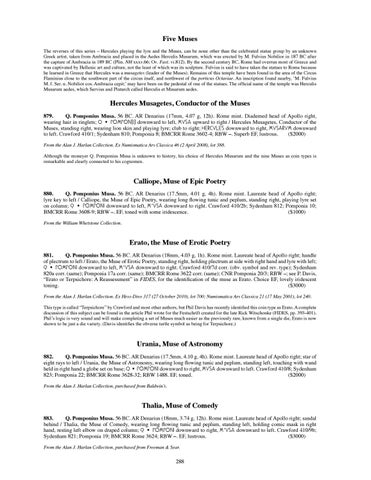Five Muses The reverses of this series – Hercules playing the lyre and the Muses, can be none other than the celebrated statue group by an unknown Greek artist, taken from Ambracia and placed in the Aedes Herculis Musarum, which was erected by M. Fulvius Nobilior in 187 BC after the capture of Ambracia in 189 BC (Plin. NH xxxv.66; Ov. Fast. vi.812). By the second century BC, Rome had overrun most of Greece and was captivated by Hellenic art and culture, not the least of which was its sculpture. Fulvius is said to have taken the statues to Rome because he learned in Greece that Hercules was a musagetes (leader of the Muses). Remains of this temple have been found in the area of the Circus Flaminius close to the southwest part of the circus itself, and northwest of the porticus Octaviae. An inscription found nearby, ‘M. Fulvius M. f. Ser. n. Nobilior cos. Ambracia cepit;’ may have been on the pedestal of one of the statues. The official name of the temple was Herculis Musarum aedes, which Servius and Plutarch called Herculis et Musarum aedes.
Hercules Musagetes, Conductor of the Muses 879. Q. Pomponius Musa. 56 BC. AR Denarius (17mm, 4.07 g, 12h). Rome mint. Diademed head of Apollo right, wearing hair in ringlets; œ • pOÂpON[i] downward to left, ÂuÍA upward to right / Hercules Musagetes, Conductor of the Muses, standing right, wearing lion skin and playing lyre; club to right; herCuLeÍ downward to right, ÂuÍAru downward to left. Crawford 410/1; Sydenham 810; Pomponia 8; BMCRR Rome 3602-4; RBW –. Superb EF, lustrous. ($2000) From the Alan J. Harlan Collection. Ex Numismatica Ars Classica 46 (2 April 2008), lot 388. Although the moneyer Q. Pomponius Musa is unknown to history, his choice of Hercules Musarum and the nine Muses as coin types is remarkable and clearly connected to his cognomen.
Calliope, Muse of Epic Poetry 880. Q. Pomponius Musa. 56 BC. AR Denarius (17.5mm, 4.01 g, 4h). Rome mint. Laureate head of Apollo right; lyre key to left / Calliope, the Muse of Epic Poetry, wearing long flowing tunic and peplum, standing right, playing lyre set on column; q • pOÂpONi downward to left, Â’uÍA downward to right. Crawford 410/2b; Sydenham 812; Pomponia 10; BMCRR Rome 3608-9; RBW –. EF, toned with some iridescence. ($1000) From the William Whetstone Collection.
Erato, the Muse of Erotic Poetry 881. Q. Pomponius Musa. 56 BC. AR Denarius (18mm, 4.03 g, 1h). Rome mint. Laureate head of Apollo right; handle of plectrum to left / Erato, the Muse of Erotic Poetry, standing right, holding plectrum at side with right hand and lyre with left; q • pOÂpONi downward to left, Â’uÍA downward to right. Crawford 410/7d corr. (obv. symbol and rev. type); Sydenham 820a corr. (same); Pomponia 17a corr. (same); BMCRR Rome 3622 corr. (same); CNR Pomponia 20/3; RBW –; see P. Davis, “Erato or Terpsichore: A Reassessment” in FIDES, for the identification of the muse as Erato. Choice EF, lovely iridescent toning. ($3000) From the Alan J. Harlan Collection. Ex Hess-Divo 317 (27 October 2010), lot 700; Numismatica Ars Classica 21 (17 May 2001), lot 240. This type is called “Terpsichore” by Crawford and most other authors, but Phil Davis has recently identified this coin type as Erato. A complete discussion of this subject can be found in the article Phil wrote for the Festschrift created for the late Rick Witschonke (FIDES, pp. 393-401). Phil’s logic is very sound and will make completing a set of Muses much easier as the previously rare, known from a single die, Erato is now shown to be just a die variety. (Davis identifies the obverse turtle symbol as being for Terpsichore.)
Urania, Muse of Astronomy 882. Q. Pomponius Musa. 56 BC. AR Denarius (17.5mm, 4.10 g, 4h). Rome mint. Laureate head of Apollo right; star of eight rays to left / Urania, the Muse of Astronomy, wearing long flowing tunic and peplum, standing left, touching with wand held in right hand a globe set on base; œ • pOÂpONi downward to right, ÂuÍA downward to left. Crawford 410/8; Sydenham 823; Pomponia 22; BMCRR Rome 3628-32; RBW 1488. EF, toned. ($2000) From the Alan J. Harlan Collection, purchased from Baldwin’s.
Thalia, Muse of Comedy 883. Q. Pomponius Musa. 56 BC. AR Denarius (18mm, 3.74 g, 12h). Rome mint. Laureate head of Apollo right; sandal behind / Thalia, the Muse of Comedy, wearing long flowing tunic and peplum, standing left, holding comic mask in right hand, resting left elbow on draped column; q • pOÂpONi downward to right, Â’uÍA downward to left. Crawford 410/9b; Sydenham 821; Pomponia 19; BMCRR Rome 3624; RBW –. EF, lustrous. ($3000) From the Alan J. Harlan Collection, purchased from Freeman & Sear.
288
